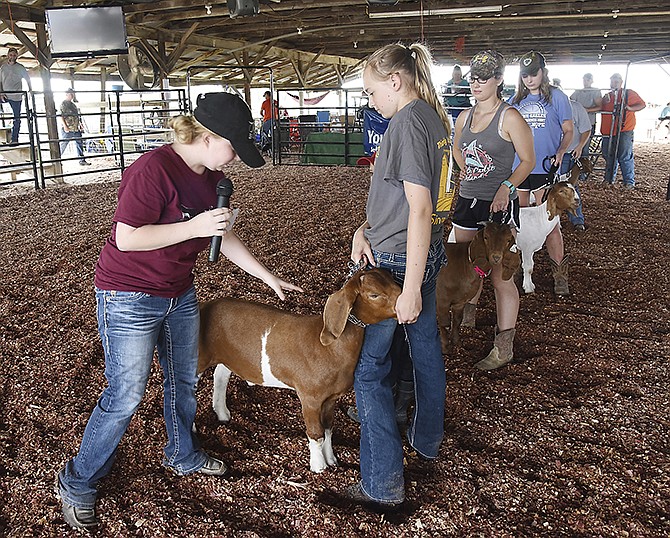How much muscle and coverage does a goat have? How round is a hog? How much fat is on a steer?
Those are questions youth were asking Wednesday morning at the Jefferson City Jaycees Cole County Fairgrounds barn.
Nearly three dozen Cole County 4-H youth observed, handled and judged four choice specimens from each livestock category - lamb, goat, hog, steer - at the Livestock Judging Contest.
The goal was two-fold - to select the top youth in the junior and senior categories to advance as teams to the state fair contest and to help youth better understand what judges look for in their show animals.
"I like to watch the goats; they're funny," said Keaton Forck, 10.
For the goats and the lambs, the young judges were invited into the arena to feel the animals. The steers and hogs were judged from the stands as older volunteers walked the animals around.
"I learn more every year," said Meagan Forck, 13.
Twin sister Morgan Forck, 13, said the sheep felt oily, and she was glad not to have to touch the hogs.
Participating in the livestock judging events as a 4-H youth, FFA member and in college prepared Shannon Yokley for life, she said.
Now working for the Brownfield Ag News, Yokley said she gained self-confidence, assertiveness, leadership, public speaking skills and an appreciation for concise communication.
"Livestock judging is about being able to make quick decisions," Yokley said. "Then, you must back up your decision."
Wednesday's county-level event "will expand their minds of what they can do," Yokley said. While in high school, she competed at nationals, missing the cut for the international competition by one place.
The opportunity to move into the more competitive levels at state and nationals provides an outlet for those who excel in livestock agriculture.
"For those not into sports, they could channel their passion and energy into livestock," she observed.
Youth may begin showing their animals at a young age. Judging helps them see what judges are looking for, Yokley said.
"Usually kids show up, already taking care of their own animals," Yokley said.
That was the case for the Forck cousins from Taos, who raise steers.
Keaton Forck noted a steer's back should be slightly concave; too much or creating a hump will damage the loin or rib meats. Morgan
Forck added a steer that stands with his head up allows someone to see its muscles better.
Learning how to judge is the opposite side of the coin from showing, Yokley said. But it will help the youth show their own animals in the future.
"You learn how to evaluate an animal and how to compare it to others," she said.
However, each judge may have a different view.
"There is no right or wrong answer; it's your ability to evaluate and express yourself," Yokley said.
The challenge is to apply knowledge in a timed setting and be able to quickly and concisely defend one's decision.
Yokley said the most difficult part for her was second-guessing herself.
But she grew from that. As an adult and in professional settings, she said she is more at ease making decisions and not fretting the consequences if something doesn't go right.
"I miss showing more than anything," Yokley said. "But judging took me to another level professionally.
"It helped educate me and for me to grow outside the box."
Related article: Moos, oinks mark first day of fair

